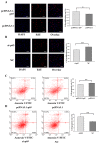P65 Targets FGFR1 to Regulate the Survival of Ovarian Granulosa Cells
- PMID: 31671754
- PMCID: PMC6912588
- DOI: 10.3390/cells8111334
P65 Targets FGFR1 to Regulate the Survival of Ovarian Granulosa Cells
Abstract
In female mammals, the abnormal apoptosis of ovarian granulosa cells (GCs) impairs follicular development and causes reproductive dysfunction. Many studies have indicated that the FGFR1 gene of the PI3K signaling pathway and the p65 subunit of the transcription factor NF-κB may regulate the proliferation and apoptosis of GCs involved in follicular development. However, little is known about whether p65 regulates the transcription of FGFR1, as well as the biological effects of p65 and FGFR1 on the survival of GCs and follicular development. In porcine follicles and GCs, we found that p65 and FGFR1 were exclusively expressed in the GCs of follicles, and the mRNA and protein levels of p65 and FGFR1 significantly increased from small to large follicles. Both p65 and FGFR1 were found to activate the PI3K signaling pathway, and the expressions of proliferation markers (PCNA and MKI67) and the anti-apoptotic gene BCL2 were significantly increased by p65 and FGFR1. Furthermore, both p65 and FGFR1 were observed to promote cell proliferation and inhibit the cell apoptosis of GCs, and p65 was confirmed to bind at the -348/-338 region of FGFR1 to positively regulate its transcription. Moreover, p65 was further found to enhance the pro-proliferation and anti-apoptotic effects of FGFR1. Taken together, p65 may target the -348/-338 region of FGFR1, promote the transcription of FGFR1, and enhance the pro-proliferation effect and anti-apoptotic effect of FGFR1 to facilitate the growth of follicles. This study will provide useful information for further investigations on the p65-mediated-FGFR1 signaling pathway during folliculogenesis in mammals.
Keywords: FGFR1; cell proliferation and apoptosis; ovarian granulosa cells; transcription factor p65.
Conflict of interest statement
The authors declare no conflict of interest.
Figures







References
Publication types
MeSH terms
Substances
LinkOut - more resources
Full Text Sources
Molecular Biology Databases
Miscellaneous

